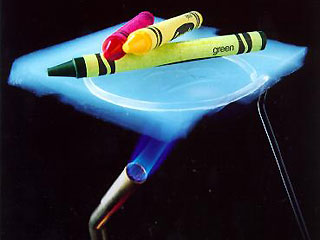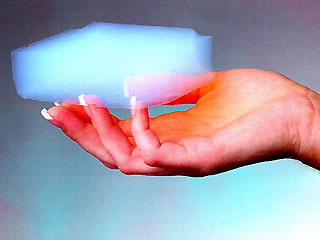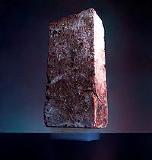Conversion Factors in Aerogels and Other Insulators
- Page ID
- 50679
\( \newcommand{\vecs}[1]{\overset { \scriptstyle \rightharpoonup} {\mathbf{#1}} } \)
\( \newcommand{\vecd}[1]{\overset{-\!-\!\rightharpoonup}{\vphantom{a}\smash {#1}}} \)
\( \newcommand{\id}{\mathrm{id}}\) \( \newcommand{\Span}{\mathrm{span}}\)
( \newcommand{\kernel}{\mathrm{null}\,}\) \( \newcommand{\range}{\mathrm{range}\,}\)
\( \newcommand{\RealPart}{\mathrm{Re}}\) \( \newcommand{\ImaginaryPart}{\mathrm{Im}}\)
\( \newcommand{\Argument}{\mathrm{Arg}}\) \( \newcommand{\norm}[1]{\| #1 \|}\)
\( \newcommand{\inner}[2]{\langle #1, #2 \rangle}\)
\( \newcommand{\Span}{\mathrm{span}}\)
\( \newcommand{\id}{\mathrm{id}}\)
\( \newcommand{\Span}{\mathrm{span}}\)
\( \newcommand{\kernel}{\mathrm{null}\,}\)
\( \newcommand{\range}{\mathrm{range}\,}\)
\( \newcommand{\RealPart}{\mathrm{Re}}\)
\( \newcommand{\ImaginaryPart}{\mathrm{Im}}\)
\( \newcommand{\Argument}{\mathrm{Arg}}\)
\( \newcommand{\norm}[1]{\| #1 \|}\)
\( \newcommand{\inner}[2]{\langle #1, #2 \rangle}\)
\( \newcommand{\Span}{\mathrm{span}}\) \( \newcommand{\AA}{\unicode[.8,0]{x212B}}\)
\( \newcommand{\vectorA}[1]{\vec{#1}} % arrow\)
\( \newcommand{\vectorAt}[1]{\vec{\text{#1}}} % arrow\)
\( \newcommand{\vectorB}[1]{\overset { \scriptstyle \rightharpoonup} {\mathbf{#1}} } \)
\( \newcommand{\vectorC}[1]{\textbf{#1}} \)
\( \newcommand{\vectorD}[1]{\overrightarrow{#1}} \)
\( \newcommand{\vectorDt}[1]{\overrightarrow{\text{#1}}} \)
\( \newcommand{\vectE}[1]{\overset{-\!-\!\rightharpoonup}{\vphantom{a}\smash{\mathbf {#1}}}} \)
\( \newcommand{\vecs}[1]{\overset { \scriptstyle \rightharpoonup} {\mathbf{#1}} } \)
\( \newcommand{\vecd}[1]{\overset{-\!-\!\rightharpoonup}{\vphantom{a}\smash {#1}}} \)
\(\newcommand{\avec}{\mathbf a}\) \(\newcommand{\bvec}{\mathbf b}\) \(\newcommand{\cvec}{\mathbf c}\) \(\newcommand{\dvec}{\mathbf d}\) \(\newcommand{\dtil}{\widetilde{\mathbf d}}\) \(\newcommand{\evec}{\mathbf e}\) \(\newcommand{\fvec}{\mathbf f}\) \(\newcommand{\nvec}{\mathbf n}\) \(\newcommand{\pvec}{\mathbf p}\) \(\newcommand{\qvec}{\mathbf q}\) \(\newcommand{\svec}{\mathbf s}\) \(\newcommand{\tvec}{\mathbf t}\) \(\newcommand{\uvec}{\mathbf u}\) \(\newcommand{\vvec}{\mathbf v}\) \(\newcommand{\wvec}{\mathbf w}\) \(\newcommand{\xvec}{\mathbf x}\) \(\newcommand{\yvec}{\mathbf y}\) \(\newcommand{\zvec}{\mathbf z}\) \(\newcommand{\rvec}{\mathbf r}\) \(\newcommand{\mvec}{\mathbf m}\) \(\newcommand{\zerovec}{\mathbf 0}\) \(\newcommand{\onevec}{\mathbf 1}\) \(\newcommand{\real}{\mathbb R}\) \(\newcommand{\twovec}[2]{\left[\begin{array}{r}#1 \\ #2 \end{array}\right]}\) \(\newcommand{\ctwovec}[2]{\left[\begin{array}{c}#1 \\ #2 \end{array}\right]}\) \(\newcommand{\threevec}[3]{\left[\begin{array}{r}#1 \\ #2 \\ #3 \end{array}\right]}\) \(\newcommand{\cthreevec}[3]{\left[\begin{array}{c}#1 \\ #2 \\ #3 \end{array}\right]}\) \(\newcommand{\fourvec}[4]{\left[\begin{array}{r}#1 \\ #2 \\ #3 \\ #4 \end{array}\right]}\) \(\newcommand{\cfourvec}[4]{\left[\begin{array}{c}#1 \\ #2 \\ #3 \\ #4 \end{array}\right]}\) \(\newcommand{\fivevec}[5]{\left[\begin{array}{r}#1 \\ #2 \\ #3 \\ #4 \\ #5 \\ \end{array}\right]}\) \(\newcommand{\cfivevec}[5]{\left[\begin{array}{c}#1 \\ #2 \\ #3 \\ #4 \\ #5 \\ \end{array}\right]}\) \(\newcommand{\mattwo}[4]{\left[\begin{array}{rr}#1 \amp #2 \\ #3 \amp #4 \\ \end{array}\right]}\) \(\newcommand{\laspan}[1]{\text{Span}\{#1\}}\) \(\newcommand{\bcal}{\cal B}\) \(\newcommand{\ccal}{\cal C}\) \(\newcommand{\scal}{\cal S}\) \(\newcommand{\wcal}{\cal W}\) \(\newcommand{\ecal}{\cal E}\) \(\newcommand{\coords}[2]{\left\{#1\right\}_{#2}}\) \(\newcommand{\gray}[1]{\color{gray}{#1}}\) \(\newcommand{\lgray}[1]{\color{lightgray}{#1}}\) \(\newcommand{\rank}{\operatorname{rank}}\) \(\newcommand{\row}{\text{Row}}\) \(\newcommand{\col}{\text{Col}}\) \(\renewcommand{\row}{\text{Row}}\) \(\newcommand{\nul}{\text{Nul}}\) \(\newcommand{\var}{\text{Var}}\) \(\newcommand{\corr}{\text{corr}}\) \(\newcommand{\len}[1]{\left|#1\right|}\) \(\newcommand{\bbar}{\overline{\bvec}}\) \(\newcommand{\bhat}{\widehat{\bvec}}\) \(\newcommand{\bperp}{\bvec^\perp}\) \(\newcommand{\xhat}{\widehat{\xvec}}\) \(\newcommand{\vhat}{\widehat{\vvec}}\) \(\newcommand{\uhat}{\widehat{\uvec}}\) \(\newcommand{\what}{\widehat{\wvec}}\) \(\newcommand{\Sighat}{\widehat{\Sigma}}\) \(\newcommand{\lt}{<}\) \(\newcommand{\gt}{>}\) \(\newcommand{\amp}{&}\) \(\definecolor{fillinmathshade}{gray}{0.9}\)Heat is transferred by convection, conduction, and radiation. Good insulators block heat transfer by all modes, and have large "R Values".

Insulators are made of materials with low heat conduction, like nonmetallic solids and gases. Heat transfer by convection is reduced by preventing gas movement by encasing it in small bubbles or cells, as in styrofoam, or eliminating gases entirely, as in vacuum bottles. Low density is desirable in an insulator because less matter means less medium for heat conduction, and, of course, lightweight materials are easier to transport and use fewer resources. A low density insulator would weigh less for a large volume (large effective R value), so to judge insulation value, we'll need to convert mass measurements to volume measurements.
Amazingly, there is a solid insulating material that has a lower density than some gases. Aerogels are extremely light foams that look like clusters of bubbles or foam. They have been called the rarest form of matter, and have the lowest density of any material known.


They are strong (the Figure shows a brick supported by a nearly invisible aerogel), and they are incredibly good insulators. A Movie shows that if one side of a 6 mm aerogel blanket is heated to 1000 ° C, the other side can still be touched. Aerogels are also good at cushioning impact, and may be used to protect sensitive equipment like hard drives. Aerogels feel like styrofoam, but look like "frozen smoke".
Table \(\PageIndex{1}\) Densities[3] and R-Values[4] of various materials
| Material | ρ / g/cm3 | R Value per inch / ft²·°F·h/Btu(K·m²/W) |
|---|---|---|
| Interstellar medium (vacuum) |
10-22 − 10-12 | R-30 (5.28) |
| Hydrogen gas | 0.000089 | |
| Helium gas | 0.00018 | |
| Still Air | 0.00128 | R-5 (0.88) |
| Convective Air | 0.00128 | R-1 (0.18) |
| Silica Aerogel | 0.0019 | R-10 (1.76) |
| Argon | 0.0018 | |
| Carbon Dioxide | 0.001977 | |
| Low density styrofoam | 0.030 − 0.120 | R-3.7 (.65) |
| Polyurethane rigid panel | 0.16-0.26 | R-6.8 (1.20) |
| Glass | 2.5 | R-1 (0.18) |
| Water, 25 °C | .9971 |
Earlier we showed how to use unity factors can be used to express quantities in different units of the same parameter. For example, a density can be expressed in g/cm3 or lb/ft3. Now we will also how conversion factors representing mathematical functions, like D = m/v, can be used to transform quantities into different parameters. For example, what is the mass of a given volume of silicon aerogel? Unity factors and conversion factors are conceptually different, and we'll see that the "dimensional analysis" we develop for unit conversion problems must be used with care in the case of functions.
When we are referring to the same object or sample of material, it is often useful to be able to convert one parameter into another. Conversion of one kind of quantity into another is usually done with what can be called a conversion factor, but the conversion factor is based on a mathematical function (D = m / V) or mathematical equation that relates parameters. Since we have not yet discussed energy or the units (joules) in which it is measured, an example involving the more familiar quantities mass and volume will be used to illustrate the way conversion factors are employed. The same principles apply to finding how much energy would be released by burning a fuel, and that problem will be encountered later.
Suppose we have a rectangular solid sample of aerogel which measures 3.04 cm × 8.14 cm × 17.3 cm. We can easily calculate that its volume is 428 cm3. We can determine the mass equivalent to a volume of 428 cm3 by manipulating Eq. (1.1) which defines density. If we multiply both sides by V, we obtain
\[V \times \rho =\dfrac{m}{V}\times V = m\label{1}\]
\[m = V \times \rho \quad \text{or mass = volume} \times \text{ density } \]
Taking the density of silica aerogels from the Table, we can now calculate
\[\text{Mass} = \text{m} = \text{V} \rho = \text{428 cm}^3 \times \dfrac{\text{0.0019 g}}{\text{1 cm}^3} = \text{0.8123 g}\nonumber\]
To emphasize the significance of this result, let's find the volume of water with the same mass as this 428 cm3 piece of aerogel. The formula which defines density can also be used to convert the mass of a sample to the corresponding volume. If both sides of Eq. (1.2) are multiplied by 1/ρ, we have
\[\dfrac{\text{1}}{\rho }\times m=V \rho \times \dfrac{\text{1}}{\rho }=V \]
\[V=m \times \dfrac{\text{1}}{\rho }\label{2}\]
So the volume of water with the same mass is \(\text{V}=m \times \dfrac{\text{1}}{\rho } = \text{0.8123} \times \dfrac{1}{0.9971} = \text{0.815 cm}^3\), less than 1 cm3 !!
Notice that we used the mathematical function D = m/V to convert parameters from mass to volume or vice versa in these examples. How does this differ from the use of unity factors to change units of one parameter?
An Important Caveat
A mistake sometimes made by beginning students is to confuse density with concentration, which also may have units of g/cm3. By dimensional analysis, this looks perfectly fine. To see the error, we must understand the meaning of the function
\[ C = \dfrac{m}{V}\]
In this case, V refers to the volume of a solution, which contains both a solute and solvent.
Given a concentration of an alloy is 10g gold in 100 cm3 of alloy, we see that it is wrong (although dimensionally correct as far as conversion factors go) to incorrectly calculate the volume of gold in 20 g of the alloy as follows:
\[20 \text{g} \times \dfrac{\text{100 cm^3}}{\text{10 g}} = 200 \text{ cm}^{3} \]
It is only possible to calculate the volume of gold if the density of the alloy is known, so that the volume of alloy represented by the 20 g could be calculated. This volume multiplied by the concentration gives the mass of gold, which then can be converted to a volume with the density function.
The bottom line is that using a simple unit cancellation method does not always lead to the expected results, unless the mathematical function on which the conversion factor is based is fully understood.
Example \(\PageIndex{1}\): Volume of Ethanol
A solution of ethanol with a concentration of 0.1754 g / cm3 has a density of 0.96923 g / cm3 and a freezing point of -9 ° F [5]. What is the volume of ethanol (D = 0.78522 g / cm3 at 25 °C) in 100 g of the solution?
The volume of 100 g of solution is
\( V = m \div D = 100 \text{ g} \div 0.96923 \text{ g} \text{ cm}^{3} = 103.17 \text{ cm}^{3}\)
The mass of ethanol in this volume is
\( m = V \times C = 103.17 \text{ cm}^{3} \times 0.1754 \text{ g /} \text{ cm}^{3} = 18.097 \text{ g}\)
\( \text{The volume of ethanol } = m \div D = 18.097 \text{ g} \div 0.78522 \text{ g / } \text{cm}^{3} = 23.05 \text{cm}^{3}\)
Note that we cannot calculate the volume of ethanol by
\(\Large \dfrac {\dfrac{0.96923 g}{cm^3} \times 100 cm^3}{\dfrac {0.78522 g}{cm^3}} \normalsize = 123.4 \text{cm}^{3}\)
even though this equation is dimensionally correct.
Note that this result required when to use the function C = m/V, and when to use the function D=m/V as conversion factors. Pure dimensional analysis could not reliably give the answer, since both functions have the same dimensions.
Example \(\PageIndex{2}\): Volume of Insulator
Find the volume occupied by a 0.8123-g sample of an insulator that might compete with an aerogel, for example styrofoam.
According to the Table, the density of styrofoam might be 0.120 g cm–3 (it depends on the foaming agent). Using Eq. (1.3),
\[\text{V} = \dfrac{\text{m}}{\rho} = \text{0.8123 g} \times \dfrac{\text{1 cm}^3}{\text{0.12 g}} = \text{567.7 cm}^3\nonumber\]
The two calculations just done show that density is a conversion factor which changes volume to mass, and the reciprocal of density is a conversion factor changing mass into volume. This can be done because of the mathematical formula, Eq. (1.1), which relates density, mass, and volume. Algebraic manipulation of this formula gave us expressions for mass and for volume [Eq. (1.2) and (l.3)], and we used them to solve our problems. If we understand the function D = m/V and heed the caveat above, we can devise appropriate converstion factors by unit cancellation, as the following example shows:
Example \(\PageIndex{3}\): Volume of Mercury
A student weights 98.0 g of mercury. If the density of mercury is 13.6 g/cm3, what volume does the sample occupy?
We know that volume is related to mass through density.
Therefore:
\( V = m \times \text{ conversion factor}\)
Since the mass is in grams, we need to get rid of these units and replace them with volume units. This can be done if the reciprocal of the density is used as a conversion factor. This puts grams in the denominator so that these units cancel:
\(V=m\times \dfrac{\text{1}}{\rho }=\text{98}\text{.0 g}\times \dfrac{\text{1 cm}^{3}}{\text{13}\text{.6 g}}=\text{7}\text{.21 cm}^{3}\)
If we had multiplied by the density instead of its reciprocal, the units of the result would immediately show our error:
\(V=\text{98}\text{.0 g}\times \dfrac{\text{13.6 }g}{\text{1 cm}^{3}}=\text{1}\text{.333}{\text{g}^{2}}/{\text{cm}^{3}}\;\) (no cancellation!)
It is clear that square grams per cubic centimeter are not the units we want.
Using a conversion factor is very similar to using a unity factor—we know the factor is correct when units cancel appropriately. A conversion factor is not unity, however. Rather it is a physical quantity (or the reciprocal of a physical quantity) which is related to the two other quantities we are interconverting. The conversion factor works because of that relationship [Eqs. (1.1), (1.2), and (1.3) in the case of density, mass, and volume], not because it is equal to one. Once we have established that a relationship exists, it is no longer necessary to memorize a mathematical formula. The units tell us whether to use the conversion factor or its reciprocal. Without such a relationship, however, mere cancellation of units does not guarantee that we are doing the right thing.
A simple way to remember relationships among quantities and conversion factors is a “road map“of the type shown below:
\[\text{Mass }\overset{density}{\longleftrightarrow}\text{ volume or }m\overset{\rho }{\longleftrightarrow}V\text{ }\]
This indicates that the mass of a particular sample of matter is related to its volume (and the volume to its mass) through the conversion factor, density. The double arrow indicates that a conversion may be made in either direction, provided the units of the conversion factor cancel those of the quantity which was known initially. In general the road map can be written
\[\text{First quantity }\overset{\text{conversion factor}}{\longleftrightarrow}\text{ second quantity}\]
As we come to more complicated problems, where several steps are required to obtain a final result, such road maps will become more useful in charting a path to the solution.
Example \(\PageIndex{4}\): Black Ironwood
Black ironwood has a density of 67.24 lb/ft3. If you had a sample whose volume was 47.3 ml, how many grams would it weigh? (1 lb = 454 g; 1 ft = 30.5 cm).
The road map
\[\text{m}\overset{\rho }{\longleftrightarrow}V\text{ }\nonumber\]
tells us that the mass of the sample may be obtained from its volume using the conversion factor, density. Since milliliters and cubic centimeters are the same, we use the SI units for our calculation:
\[\text{Mass} = \text{47.3 cm}^3 \times \dfrac{\text{67.24 lb}}{\text{1 ft}^3}\nonumber\]
Since the volume units are different, we need a unity factor to get them to cancel:
\[\text{m} = \text{47.3 cm}^3 \times \dfrac{\text{ 1 ft}^3}{\text{30.5 cm}^3} \times \dfrac{\text{67.24 lb}}{\text{1 ft}^3} \times \dfrac{\text{454 g}}{\text{1 lb}} = \text{50.9 g}\nonumber\]
In subsequent chapters we will establish a number of relationships among physical quantities. Formulas will be given which define these relationships, but we do not advocate slavish memorization and manipulation of those formulas. Instead we recommend that you remember that a relationship exists, perhaps in terms of a road map, and then adjust the quantities involved so that the units cancel appropriately. Such an approach has the advantage that you can solve a wide variety of problems by using the same technique.
Web Sources: http://www.allmeasures.com/Formulae/static/materials/15/density.htm
From ChemPRIME: 1.9:Conversion Factors and Functions
References
Contributors and Attributions
Ed Vitz (Kutztown University), John W. Moore (UW-Madison), Justin Shorb (Hope College), Xavier Prat-Resina (University of Minnesota Rochester), Tim Wendorff, and Adam Hahn.


